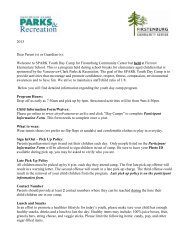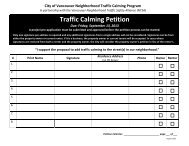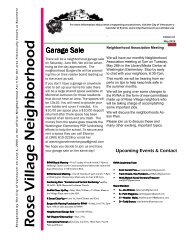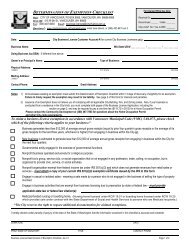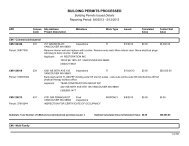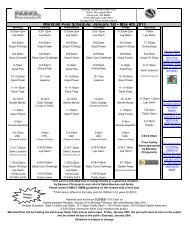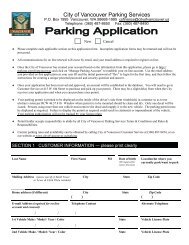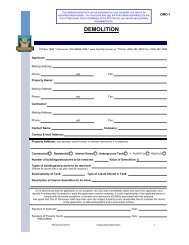Vancouver Comprehensive Plan 2011-2030 - City of Vancouver
Vancouver Comprehensive Plan 2011-2030 - City of Vancouver
Vancouver Comprehensive Plan 2011-2030 - City of Vancouver
- No tags were found...
Create successful ePaper yourself
Turn your PDF publications into a flip-book with our unique Google optimized e-Paper software.
In the unincorporated portion <strong>of</strong> the <strong>Vancouver</strong> residents that use them, and a network <strong>of</strong> roads,Urban Growth Area, Clark County has completed sidewalks, and bike paths to reach these destinationseasily. This concept is also known as thea subarea plan for the Highway 99 corridor immediatelynorth <strong>of</strong> <strong>Vancouver</strong> city limits and is in “20-minute neighborhood”, and is based on thethe process <strong>of</strong> developing additional subarea plans idea is that encouraging more accessible publicin the surrounding Three Creeks special planning and private amenities nearby can help maintainarea. These areas are not anticipated to be annexed or enhance the convenience, livability and distinctiveness<strong>of</strong> individual neighborhoods. It can alsoto the <strong>City</strong> <strong>of</strong> <strong>Vancouver</strong> until approximately 2020or later.provide a wider range <strong>of</strong> transportation choicesincluding shorter drives, walking, transit, or otherDevelopment within centers and corridors thatoptions, and can generally promote opportunitieshave existing services is generally more efficientfor community interaction and social cohesion.and cost effective than elsewhere, and can in turnsupport additional service investments. For transit Data for this concept is available at the websiteservice, the Institute <strong>of</strong> Traffic Engineers manual Walk Score, which calculates the proximity <strong>of</strong>and C-Tran recommends that housing densities stores and other land use destinations to housing,<strong>of</strong> at least 7 units per acre are needed to support <strong>Vancouver</strong>’s citywide score in <strong>2011</strong> is estimatedservice every ½ hour, or at least 80-200 employees at 50 on a scale <strong>of</strong> 0 to 100, slightly ahead <strong>of</strong> theper acre in non-residential areas. To support serviceevery 10 minutes, 15 housing unit per acre or (48), and the scores for the cities <strong>of</strong> Battle Groundaverage for midsize and larger Washington cities200-500 employees per acre is recommended.(49) and Camas (36). The <strong>City</strong> <strong>of</strong> Portland receiveda score <strong>of</strong> 67. Walk Score reflects proximity <strong>of</strong> variousland uses, not sidewalk condition or measuresFacilitating connected neighborhoods andcommunities<strong>of</strong> connectivity. A score below 50 indicates mostThe <strong>Comprehensive</strong> <strong>Plan</strong> envisions <strong>Vancouver</strong>trips require a car. Figure 1-3 illustrates how Walkneighborhoods that have restaurants, stores, public Scores vary within <strong>Vancouver</strong>. Green areas withfacilities, and employment opportunities near the mixes <strong>of</strong> land use that are most conducive to walkingor short drives areFigure 1-3. Areas in <strong>Vancouver</strong> with land use mixes conducive to walking (100 best)in downtown andareas to the north,near portions <strong>of</strong>Fourth Plain Blvd,and portions <strong>of</strong>Mill Plain Blvd east<strong>of</strong> I-205.Source: Walk Score (http://www.walkscore.com/WA/<strong>Vancouver</strong>)<strong>Vancouver</strong> <strong>Comprehensive</strong> <strong>Plan</strong> <strong>2011</strong>-<strong>2030</strong> Community Development | 1-9




